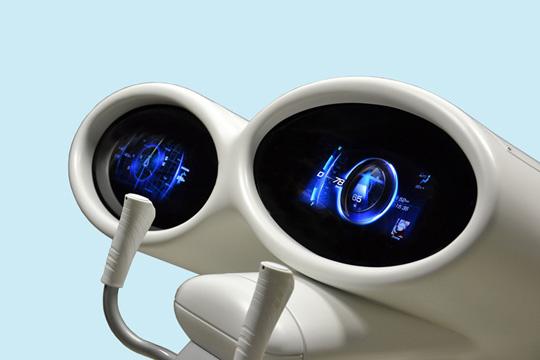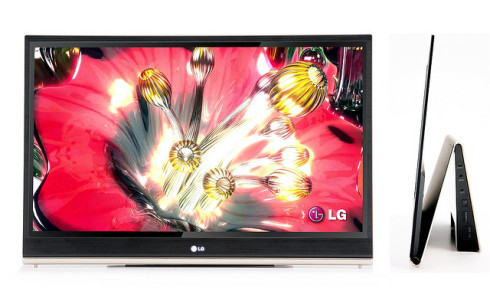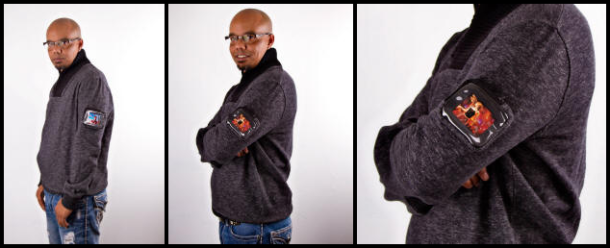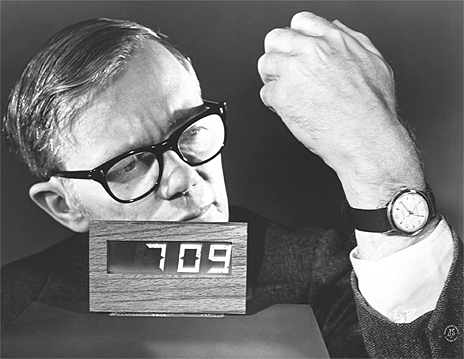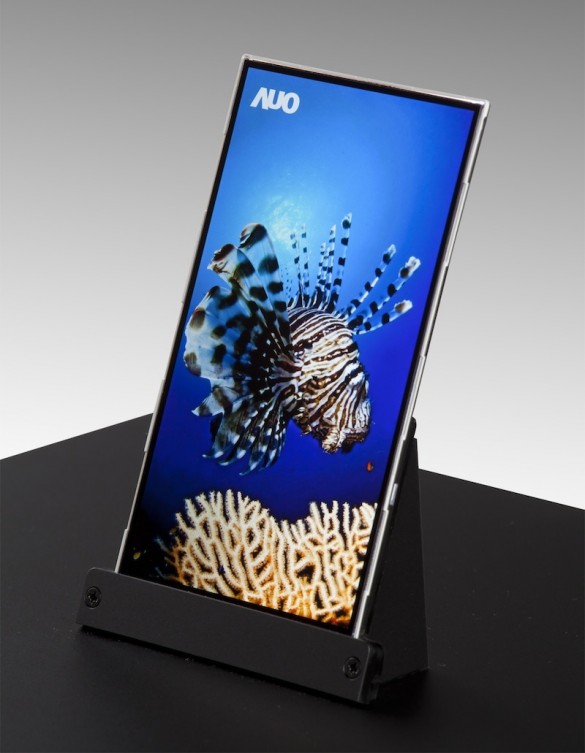
Image via Sharp
How will Sharp's free-form display affect design? "The electronics maker has announced a prototype Free-form Display that can be made in whatever two-dimensional shape is required. Potential applications include dashboard displays incorporating multiple circular contours, wearable computers with elliptical screens, tablets and smartphones without frames, and complex digital signage. Instead of incorporating the gate driver on the perimeter of the display, the Sharp prototype disperses its function throughout the screen’s pixels. The bezel, or area that surrounds the screen, can thus be shrunk. While it’s not the first non-rectangular LCD screen, Sharp’s prototype is the first thin-bezel LCD that allows for various screen shapes, the company said." via PC World
Samsung's $1 billion LCD plant in Vietnam "In 2009 Samsung inaugurated its mobile phone production plant Samsung Electronics VN in the northern province of Bac Ninh. The plant had an initial investment of $670 million, which eventually increased to $2.5 billion.
Four years later, the $2 billion Samsung Electronics VN Thai Nguyen complex broke ground in Thai Nguyen, another northern province. Around 43,000 employees are working at the Bac Ninh facility, and the Thai Nguyen complex is expected to attract up to 50,000 workers. It is estimated that Samsung’s two plants in Vietnam will produce $35 billion worth of mobile phones this year." via Tuoi Tre News
Are Samsung’s New AMOLED Tablets Better Than Their LCD Tablets? "Samsung will certainly be preaching about the advantages of its AMOLED display – take a look through some of the photos in the gallery and you will see that when it comes to Color Reproduction, using the Adobe RGB Gamut that the AMOLED display captures 94-percent and the LCD only 74-percent. When it comes to Contrast Ratio, you can get 100,000:1 versus 1,000:1 on the LCD display. This higher Contrast Ratio offers more vivid – jump out at you – colors and deeper blacks than the LCD technology can provide. Many users have complained that the AMOLED display does not faithfully reproduce the colors of the original image, while AMOLED supporters say they enjoy getting a more attractive display experience." via AndroidHeadlines
What is AU Optronics' place in the display industry? "It wasn’t until the mid- to late- 2000s that LCD displays swamped the consumer electronics market. Suffice it to say, they’ve had an incredible impact in a short time. As such, AU Optronics has similarly high impact in the industry...although few seem to know it. The company makes both LCD and AMOLED displays with its thin-film transistor (TFT) technology. Each display works differently, and with consumer demand for both, AU Optronics is satisfying that demand. Its Hyper-LCD displays offer even greater viewership through “Advanced Hyper-Viewing Angle” (AHVA) technology, which gives flawless picture quality, even at various angles. But its AMOLED technology is really raising the bar." via Trefis
How does Amazon's Fire Phone create a 3D multi-perspective display? "Amazon's finally unveiled its first smartphone: the Fire Phone. And, as expected, there are 3D-like features on board, with something the company's calling Dynamic Perspective. ...Bezos said during the presentation that getting Dynamic Perspective ready for everyday users wasn't easy. "The key is knowing where the user's head is at all times," he stated, citing the need to have multiple cameras (remember those?) on the Fire Phone to make the feature work properly. In total, the device has six cameras -- four of which have a 120-degree field of view and are used specifically for Dynamic Perspective, plus your usual front and rear shooters." via engadget
How is Corning's anti-reflective display coating revolutionary? "The anti-reflective coating needs to be applied to both sides of the display and will drop the reflectivity of the screen from standard 8% to mind-boggling 1%. The coating which is applied using Zero Air Gap technology reduces reflection as you can see from the video below. ...The coating improves contrast and outdoor readability from 40% to a staggering 123%. There is a 90% reduction in reflectance, while the display will deliver 3X more colour in outdoor situations. (Video)" via Techtree
Could virtual reality displays be made consumer-ready with eye tracking? "Kreylos explains that the distance between your pupils is not always constant, and human eyes will occasionally swivel inward to make the light from a perceived object precisely hit the high-resolution fovea on the eye's retina, depending on how virtually “far away” an object is. Kreylos explains that your eyes can “swivel in” if the screens are displaying something particularly close to you in the virtual space (like when you would bring a finger to your nose to go cross-eyed as a kid), and that can cause nausea without eye-tracking because the image projected by the Oculus will appear distorted as well." via Ars Technica
Display database for engineers Search thousands of display panels by multiple characteristics and compare results side-by-side using the display database multisearch.
Bosch introduces “combiner” head-up displays for BMW "The combiner system merges the images that are generated by the car’s instrument panel with the scenery outside and makes the combined picture look as if it is two meters in front of the vehicle. The information isn’t projected on the windshield but is displayed on a small plastic screen placed just before it. The technology can be fitted to various types of car models without any major technical modifications. Bosch said the new type of head-up display provides easier visual access to the information because a driver doesn’t have to refocus as much as with conventional systems." via automotiveIT
LG Loses Exclusive Supplier Contract for Apple's In-Cell Displays "To save face, LG is now saying that they had been experiencing numerous limitations bound by an agreement for exclusive supply right with Apple, which holds a number of patents. LG Display can now broaden the scope of its movements as the exclusive supply agreement has expired recently and it has secured "Advanced In-cell Touch (AIT)" technology to avoid limitations imposed by Apple's patents. The report further noted that LG Display developed AIT to circumvent Apple's patents. The biggest difference between AIT with In-cell touch display for Apple is that it is applied with self-capacitance technology, which evolved from the conventional touch type to an individual recognition of the fingers touching the display. Apple has adopted mutual-capacitance technology to concurrently recognize a multiple number of fingers." via Patently Apple
When a brand name outlives its founding technology: PureView and CBD "One of the most frustrating things about marketing and branding, from my engineer's standpoint, is that technologies get brand names assigned to them (which is fine) and then the brand name gets used elsewhere, for something totally different. ...Now, Nokia owns the 'brand' here. If it (or, in this case, now Microsoft, I guess) wants to use 'ClearBlack Display' to refer to a simple lamination then that's absolutely its perogative. Heck, Nokia could use CBD branding on a toaster if it liked - it can do what it likes with its own marketing brand. But it's the changing definition that leaves technologically-minded users confused. Even more so because the new 'definition', an ambiguous 'aim', has been applied in a device with definitively worse outdoors performance. The PureView change was at least a totally different direction that was intended to be folded into the original tech in the future. This 'ClearBlack Display' definition change just muddies the waters, in my opinion." via All About Symbian
Is OLED Dead? "UltraHD sets were once again everywhere at CES 2014, while OLED had a lower-profile presence. Most of the OLED TVs were curvy this year. Some could even transform from flat to curved. They all looked good, but the novelty of seeing UltraHD sets and OLED sets had largely worn off. It was the third straight year they were on display at CES. Instead, the most interesting developments at the show involved dramatic improvements in LCD picture quality. Advancements in LCD panels are closing the picture-quality gap between OLED and LCD—and the latter are much more affordable and cheaper to produce." via Wired
Why is AUO no longer merging with Innolux? "Taiwan's Ministry of Economic Affairs has given up plans to have domestic flat panel makers AU Optronics (AUO) and Innolux merge due to a disagreement on the leadership after the merger, our sister paper Commercial Times reported on June 17. ...Officials said that the ministry's research predicted potential for 15% growth for the country's flat panel sector after the merger. Yet now that the two companies have worked out debt repayment plans with banks, the merger plan became less important for both, as they have received more orders over the past few months." via WantChinaTimes
Will Taiwan's flat panel display industry be overtaken by rivals? "Taiwan's flat panel display exports to China have lagged behind South Korea for the fifth consecutive year.
The island fears it will lose more market share to its rivals, especially after Seoul and Beijing complete their free trade deal at the end of the year. Taiwan was once the world's biggest flat panel display supplier to the greater China market. Between 2003 and 2008, Taiwan held more than 35 per cent of the Hong Kong-China market. But while Taiwan sat on its laurels, China and South Korea started cranking out flat panels." via Channel NewsAsia
What new high-quality polymer could be used for LCD glass? "Asahi Kasei Chemicals has developed new transparent polymer for high performance optical applications, which is now ready for commercial production. The material called AZP offers zero birefringence by using novel molecular design. Asahi Kasei is building new manufacturing facilities for production of AZP at its Chiba Plant (Sodegaura, Chiba, Japan). This new material is expected to replace glass in LCD panels used in smartphones, and in-car navigation systems." via EE Herald
Do you have content to share with Display Alliance? Anyone can post press releases, white papers, commentary, videos, and more in the open section.
SID Applauds Winners of Display Industry Awards "The Society for Information Display (SID) celebrated the winners of the Display Industry Awards, Display Week Best in Show and I-Zone during its annual Awards Luncheon yesterday. This year’s winners include: 2014 DISPLAY INDUSTRY AWARDS Display of the Year: Granted to a display with novel and outstanding features such as new physical or chemical effects, or a new addressing method." via Display Central
Could Touchscreens Be Reinvented By This Tiny Startup? "Qeexo is hoping to emulate Steve Jobs. Backed by $2.3 million, the San Jose, California-based startup has developed a new touchscreen technology that can detect the difference between a fingertip, a knuckle, a fingernail, and a stylus. By assigning different parts of the finger to different actions, this technology–known as FingerSense–could reduce tasks that currently require multiple steps to just one. “You can imagine it’d be like having different buttons in your hand,” explain’s Sang Won Lee, the company’s co-founder and CEO. The iPhone, and indeed the entire smartphone industry, have evolved dramatically since that day in 2007. And yet, for all the features that have been tweaked and perfected over the years, the language Jobs taught us has remained unchanged. We still use a single input–a fingertip–to operate the device. And that limits the way we use our phones. " via Wired
Will Touchscreens Soon Be Shatterproof? "That heartbreak may be a thing of the past due to research out of the University of Akron: a new transparent electrode material that makes the screen virtually shatterproof. There has been a huge push in nanomaterial research with the aim of finding a replacement for indium tin oxide (ITO), which is the material from which transparent conductors that control screen pixels are made. One of the problems with ITO is that it’s a relatively scarce resource, and with the market for tablets and smart phones exploding, that scarcity has become more acute. This market shortage, combined with the brittleness of ITO-based screens, explains why a variety of nanomaterials have been given a “market pull” opportunity rather than merely a “technology push” prayer." via IEEE Spectrum
TFT displays can be cut to size "TFT displays of a custom size, and optically bonded displays for example, are becoming available with initial non-recurring engineering (NRE) charges a fraction of those associated with a full custom display and the minimum economic order is low. For example, designers everywhere are keen to eliminate drab LCD character modules from their systems and replace them with colour graphic displays, often including touch control. However, TFT displays are made in standard formats and until now, the cost of manufacturing a custom size has been uneconomic for most industrial applications.
Manufacturers now have flexible processes which make it is possible to cut standard small format TFT displays to a specified height, opening up new application areas." via Electronics Weekly
How to implement haptics in touch-based user interfaces "Transitioning from mechanical buttons, knobs, and dials to a capacitive touch interface, however, poses a challenge to designers because there is no tactile feedback present with capacitive touch sensors as exists with mechanical buttons and switches. For example, consider the experience of typing on a keyboard. When a key is pressed and released, it bounces back due to spring action. A person can feel the force of the key bouncing back with his or her finger and thereby confirm the key press. With a capacitive touch interface, there is no inherent mechanical feedback, and users do not have the same experience as that of mechanical keys. The absence of tactile feedback poses a challenge to designers in that their primary goal is to improve user experience. Through haptics technology, developers can provide tactile feedback, improve the user experience, and add value to products." via EDN
Is thermal touch a new interface option? "We’ve been conditioned as technology users to look for touch -- it’s really the default user interface for most technology now. Wearable device makers have proposed multiple interface solutions: voice navigation, depth tracking for finger detection, companion devices, and even things as novel as shoulder-mounted projectors. Though these options are a great start, we’ve found many of them lacking, or even, frustrating for the average user. But what if we could turn any surface into a touchscreen? This was the idea we tasked ourselves with after discovering the potential gain in marrying thermal imaging with traditional computer vision algorithms. Our mobile prototype runs on a Lenovo ThinkPad tablet PC, to which we attached a combined thermal and visible light camera module. The fixture is simply a joist hanger I purchased at a local hardware store. (Video)" via EE Times
7 Futuristic Display Interfaces from MIT's Media Lab "Any design nerd, futurist, or techie worth his weight in salt has heard of the MIT Media Lab. Few, however, have heard of the Fluid Interfaces Group. No, it’s not a smooth jazz outfit—it’s a division of the famous Media Lab, and home to some of the niftiest display prototypes and interface designs this side of the Mississippi. ...Fluid has been around for at least seven years, but recent advances in mobile, sensor, and display technology seem to have inspired a wealth of breathtaking new projects. Here are seven recent ideas that offer a glimpse at the future of interface technology." via Reviewed.com
Are you an engineer or have display expertise? Email jason@displayalliance.com to be featured in the interviews section.
Where are cockpit displays headed? Q&A with cockpit manufacturer Continental "By just looking at a 10 year old cockpit, we would immediately see what is expected nowadays for a mid-range segment: it has to look high tech with a full colour TFT [thin film transistor] display in the cluster as well as in the centre stack. For the secondary display, touch functionality is becoming the norm. It has to be connected to your smart phone - USB, BT, mirror link - and include a lot of sensors mainly related to safety such as rearview camera, rain detection and park assist. With the increasing number of functions in the car, ease of use is becoming more and more important. So, a well structured HMI [human machine interface] concept is required." via just auto
Google Glass Enters the Operating Room As Medical Display "The Glass projector is slightly above the user’s right eye, allowing doctors to see medical information without turning away from patients. But the display can also be used to see email and surf the web, potentially allowing doctors to take multitasking to dangerous new levels, said Dr. Peter J. Papadakos at the University of Rochester Medical Center, who has published articles on electronic distractions in medicine. “Being able to see your laparoscopic images when you’re operating face to face instead of looking across the room at a projection screen is just mind-bogglingly fantastic,” he said. “But the downside is you don’t want that same surgeon interacting with social media while he’s operating.”" via The New York Times
Will next-gen smartphones have sensors built into display glass? "Corning International, which makes the material commonly used in mobile device screens, has teamed up with researchers at Polytechnique Montreal to create a new type of glass that incorporates transparent sensors. Soon, the glass in your smartphone screen could be used to take your temperature, among many other possibilities. The team used lasers to carve photonic waveguides into regular Gorilla Glass, at varying levels within the thickness of the glass. Each one of these acts as a tunnel, which photons can travel through in the same way that electrical currents flow through copper wires." via gizmag
Are 3D holographic displays on their way? "Carlsbad, Calif.-based Ostendo Technologies is readying a potentially game-changing technology that may make its way into upcoming generations of connected gadgets. In such a scenario, visuals can be rendered three-dimensionally, as holograms. This means that tedious tasks, such as shopping for a couch on your smartwatch, would be made easier with the option of beaming up life-sized replications. ...An industry veteran and the former chief executive of mobile chipmaker CommQuest, Hussein S. El-Ghoroury has spent the last eight years homing in on a way to shrink the entire process down to a circuit the size of a piece of chewing gum. He made his first breakthrough using a technique that allowed silicon to effectively bond with light-emitting diodes, which he compares to mixing oil with water." via The Washington Post
Miyamoto Interested in Virtual Reality, But Sees a Conflict With Wii U ""We've been doing our own experiments with virtual reality dating back to the Virtual Boy," he said, referencing Nintendo's failed VR system released in 1995. "And even to some degree, the 3DS was designed with a little bit of this in mind with its stereoscopic 3D. So we're always looking at hardware and assessing what's possible." He pointed out that, while the price of VR has begun to drop, "It's still not at a cost basis that makes it easy for everyone to purchase as a mass-market product." "As game designers, we at Nintendo are interested in VR technology and what it can do, but at the same time what we're trying to do with Wii U is to create games for everyone in the living room," he continued. "We want the Wii U to be a game system that brings video gamers into the living room."" via Gamespot
Manufacturing: The forgotten industrial digital signage application "Imagine an industrial plant where management wants to communicate vital information to hundreds of workers. Perhaps it's production quotas vs. actual performance; perhaps it's mean time between accidental employee injuries; perhaps it's delivery information regarding vital components that are en route. In all of these instances — and others too numerous to recount here — digital signage has the ability to convey to a workforce important information that is vital to employees maintaining a safe, efficient environment. Digital signage for manufacturing is an excellent reminder that ROI can occur in so many ways; let’s not forget it when we figure ROI for any industry." via Digital Signage Today
Sony Delivers Immersive Keynote at SID Display Week 2014 "At SID Display Week 2014 in San Diego, CA, USA on June 3, Sony executive Dr. Kazumasa Nomoto delivered an opening keynote address that laid out the firm’s view of the future for their display products. Dr. Nomoto chose to frame his presentation around the immersive nature of the display viewing experience using the term “Immersiveness.” The presenter identified the factors influencing display immersiveness as Resolution (4K/8K), Size, Wide Color Gamut (WCG), High Dynamic Range (HDR), and High Frame Rate (HFR). For example, he cited the effect of high display resolution on Immersiveness contrasting a 2K (1920×1080) HD display viewed at a distance of 3 screen heights resulting in a 30 degree display field of view with the more immersive viewing experience resulting from viewing a 4K (3840×2160) 4K (UHD) display viewed at a distance of 1.5 screen heights yielding a 60 degree field of view. Both distances correspond the the minimum distance to not see pixels." via Display Central
What did you think about today's news? Leave a comment here and share your thoughts.

 News Roundup tagged
News Roundup tagged  AMOLED,
AMOLED,  AMS767KC04-1,
AMS767KC04-1,  Apple,
Apple,  Hot Offer,
Hot Offer,  LCD,
LCD,  LG,
LG,  OLED,
OLED,  Quantum dots,
Quantum dots,  Samsung,
Samsung,  Sharp,
Sharp,  TV,
TV,  iPhone
iPhone 



